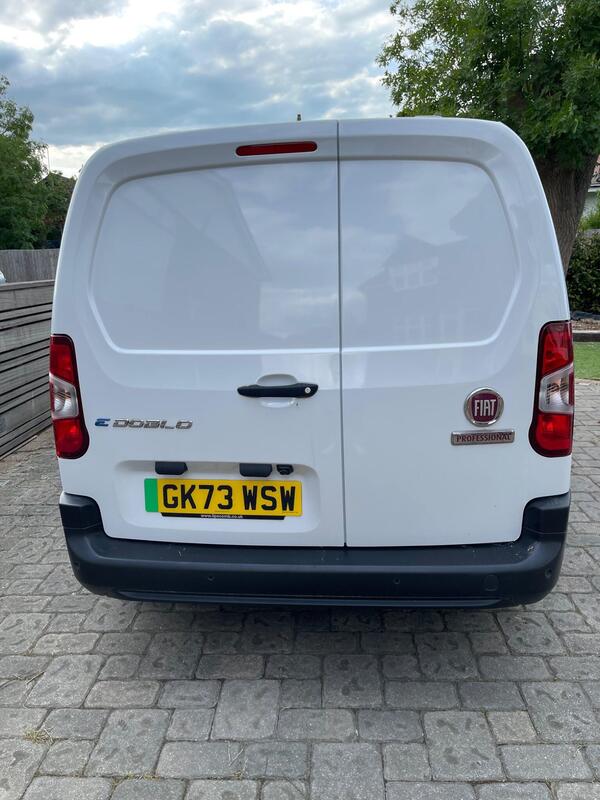Expert Review
Fiat E-Doblo Panel Van (2022 - ) Electric review
If you want to cut your everyday business costs, but still have a van that can tackle most of your work needs, then the Fiat e-Doblo is an excellent option.
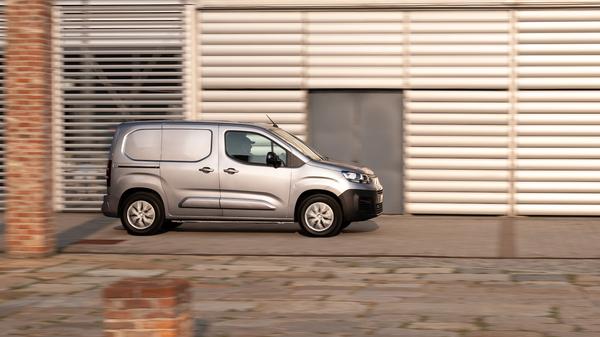

Words by: Auto Trader
Published on 15 February 2023 | 0 min read
The Autotrader expert verdict:
4.3
Yes, it costs around £10,000 more than an equivalent diesel Doblo, but the amount you'll recoup in low running costs will quickly cancel out the difference. Adding electric drive doesn't compromise the e-Doblo's cargo volumes, while payload weights are as good as you'll get from any electric van. Fiat Professional's optional 555 aftersales package could tempt buyers from similar rivals, too.
Reasons to buy:
- Roomy cargo area
- Easy to drive
- Fast charging available
Cargo & practicality
As with the combustion-engined Fiat Doblo, there are three body options available for the e-Doblo: a standard van, long-wheelbase Maxi version and a five-seat Crew Van that's based on the Maxi. All three have the same cargo volumes as their non-electric equivalents, too, because the electric motor goes under the bonnet, while the 50kWh battery is located under the cargo floor. You get 3.3 cubic metres of space in the standard van and 3.9 cubic metres in the Maxi, while the Crew Van has 3.5 to 4.0 cubic metres of space, depending on the configuration of the adjustable bulkhead. The panel vans can be had with an optional through-loading bulkhead that Fiat calls Magic Cargo. This adds a twin passenger seat that folds to reveal an opening in the metal bulkhead behind, which adds an extra half a cubic metre of space and the option to load longer items (up to 3.4 metres long) in the Maxi van. The main cargo area is square in shape and has room for two Euro pallets, while a payload of 800kg is quoted for all variants. This is a little short of the combustion engined Doblo, which can carry up to one tonne, but competitive with rival small electric vans.
Expert rating: 5/5

Interior
Since the e-Doblo is based on a conventional diesel van, the cabin is fairly ordinary, featuring lots of black plastic and hard-wearing fabric seat trim. That's no bad thing, because the cabin layout is logical, and everything is easy to operate. There's a two-seat cab in the panel van, or the option of three seats if you add the optional Magic Cargo bulkhead - although interior space is a little on the tight side if you're travelling three-up, especially for middle-seat legroom. The only real difference between the interiors of the e-Doblo and standard Doblo resides in the instruments, where an energy flow gauge replaces the rev counter. A digital display between the dials also shows energy use, range and consumption, or it can be set to show navigation instructions if you've added it as an option. Cabin storage is good, though. Starting from the top, there are two overhead shelves for documents, a cubby in the middle of the dashtop, a deep glovebox that can take a small laptop, good door bins and a shelf just above the climate controls for a smartphone, although this is a little shallow for large phones.
Expert rating: 4/5
Running costs
It's a rule of thumb that electric vans are more expensive to buy than an equivalent diesel, but their everyday running costs are a lot cheaper. The price gap between the two types of van is closing, but the e-Doblo is still around £10k more than an equivalent diesel Doblo. An electric van will be cheaper still to operate if you avoid public charging and are able to top up at home or at work. In addition, buying an electric van will reduce your tax costs, while they're future-proofed against local authorities introducing zero-emissions zones. Used values should also be strong as demand for electric vans increases. Service intervals are every two years or 25,000 miles, depending on which comes first, although the first service needs to be carried out after the first year or 12,500 miles. If you choose Fiat Professional's 555 deal, you'll get a warranty, servicing and roadside assistance that all last for five years.
Expert rating: 5/5
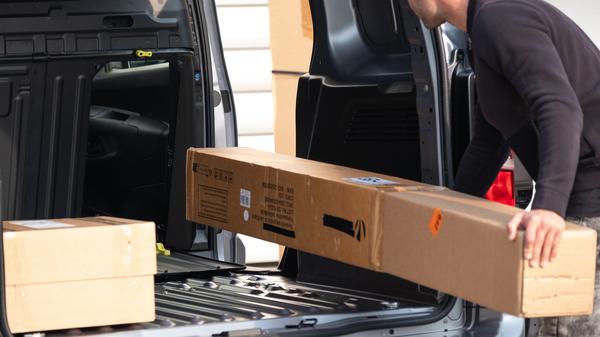
Reliability
While the Fiat e-Doblo was launched in 2022 as an all-new model, the eagle-eyed will recognise that it's another version of a van that first arrived in 2018. Essentially, Fiat has taken the Citroen Berlingo and added its own corporate look and specified its own model line-up to create the Doblo - and the running gear under the skin is identical. That should be good news for reliability, because any teething troubles that may have arisen during production since 2018 should have been ironed out. And since electric models have fewer moving parts that could possibly go wrong, then reliability should be fine. One advantage that the Fiat e-Doblo has over the Berlingo (and the Peugeot e-Partner and Vauxhall Combo-e, which use the same tech) is Fiat's optional five-year warranty package - this is only bettered by the Toyota Proace City Electric (another van that uses the same tech), which can have 10 years of cover if you get it serviced at a Toyota dealer. All of these vans come with an eight-year/100,000-mile warranty for the drive battery.
Expert rating: 5/5
Performance
The e-Doblo features a 136hp electric motor up front that drives the front wheels, and performance is pretty strong when compared with a diesel van. There's a 0-62mph time of 11.7 seconds, but the electric motor's instant torque delivery means that acceleration from a standstill and at lower speeds is rapid, although the van runs out of steam at higher speeds. As standard, the Fiat e-Doblo starts off in Normal mode, while there are Sport and Eco settings also on offer. In the Normal set-up, power is limited to 110hp, but this is perfectly acceptable for everyday use. Select Power mode, and the full 136hp is offered, but the van feels snappy in its response, which takes a bit of getting used to and we'd only recommend it for use with heavy payloads. Eco mode goes the opposite way and blunts the van's response to accelerator inputs quite drastically. Power is limited to 82hp and the climate control is shut down to preserve range, which is handy if you're a little short of range in Normal mode. Power mode reduces range by around 10 miles, while the Eco setting increases this by around 10 miles. Fast-charging capability means the e-Doblo can be quick to top up, with a 0-80 per cent charge possible in half an hour from a 100kWh source. The 7.4kWh on-board charger means a wallbox charge takes 7h 30 minutes, while adding 11kWh charging brings the charge time down to five hours.
Expert rating: 5/5
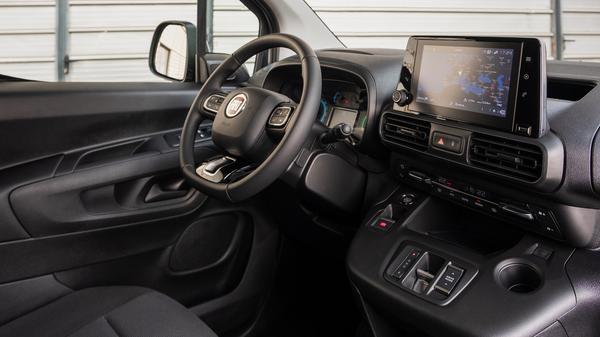
Ride and handling
Adding electric drive to the Doblo means it's exceptionally smooth and surprisingly relaxing from behind the wheel. The Normal drive mode is perfectly acceptable for everyday use, while a 'B' mode for the powertrain helps to recoup energy back into the battery when slowing down. The sensation is much like sticking a manual gearbox into a lower gear, and is good to use around town, although it does result in jerky progress when cruising at higher speeds. The weight of the battery smooths out the ride, while the low-slung pack helps with stability in corners by reducing the centre if gravity. Light steering means the e-Doblo is a breeze to manoeuvre, while optional parking sensors and cameras can assist with this.
Expert rating: 5/5
Safety
The e-Doblo's platform uses technology that's sourced from the Stellantis Group's car range, so it comes with plenty of safety equipment, although the more advanced kit is optional. You only get a driver’s airbag as standard, but there is an SOS system that can contact emergency services in the event of something going wrong. Optional safety kit comprises a front camera system with lane departure warning and lane keep assist, speed sign recognition, driver drowsiness alert and forward collision warning, along with emergency braking with pedestrian detection.
Expert rating: 4/5
Equipment
There are two trim levels for the e-Doblo at launch – standard and Primo. All vans come with an eight-inch touchscreen featuring navigation, a DAB digital radio, Bluetooth, Apple CarPlay and Android Auto, while an electric parking brake is standard, too. There's a full-height steel bulkhead, auto lights and wipers and an alarm, while the Maxi model features twin sliding side doors, compared with a single nearside door for the standard-length van. On top that, the Primo model adds rear parking sensors and a camera, the Magic Cargo through-loading bulkhead and twin passenger seat, electric windows, heated mirrors, plastic wheel trims and uprated exterior trim. Fiat offers a range of packs that bundle relevant options together. One option of note is the on-board charger upgrade. This takes it up from a 7.4kW unit to an 11kW version, which brings the charging time potential down to 5h from 7h 30m, which could save time during a working day.
Expert rating: 4/5
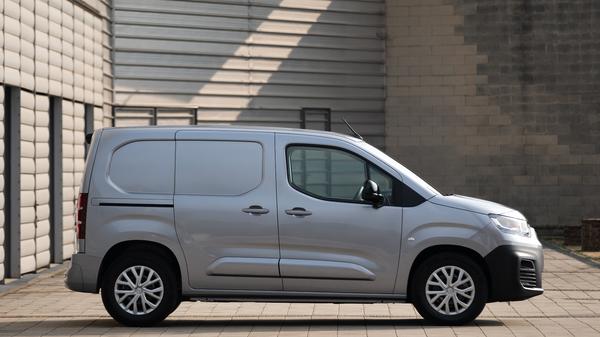
Why buy?
While the Fiat e-Doblo is just a rebadged version of a model that has already been launched, it's still worth a look. It offers all of the same positives as the similar Citroen, Peugeot, Vauxhall and Toyota models, but a different price structure and the five-year warranty and servicing package could swing buyers Fiat's way. The usual caveats about an electric van remain, in that it makes more sense to users that spend most of their time in urban areas. But the reasonable driving range means it's not out of the question to be able to undertake a longer trip, especially when you factor in the e-Doblo's fast-charging capability.
Expert rating: 5/5
